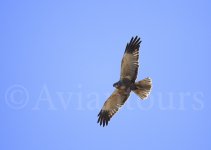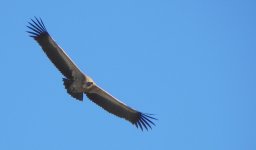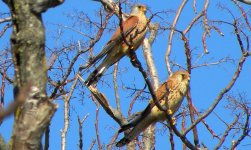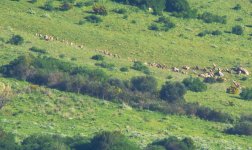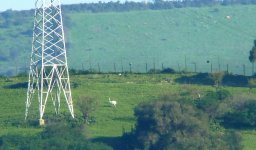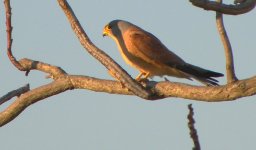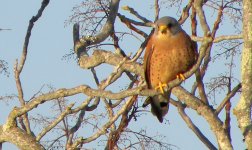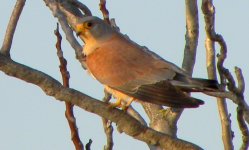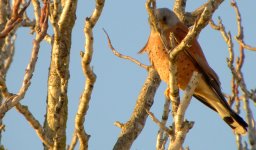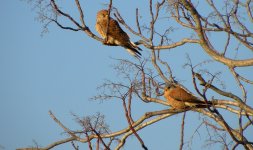-
Welcome to BirdForum, the internet's largest birding community with thousands of members from all over the world. The forums are dedicated to wild birds, birding, binoculars and equipment and all that goes with it.
Please register for an account to take part in the discussions in the forum, post your pictures in the gallery and more.
You are using an out of date browser. It may not display this or other websites correctly.
You should upgrade or use an alternative browser.
You should upgrade or use an alternative browser.
Bird of prey migration. (1 Viewer)
- Thread starter Birdman7
- Start date
More options
Who Replied?John Cantelo
Well-known member
Keep 'em warm for me - I'll be down in Spain by the end of the week!
June Atkinson
Well-known member
Black kites
But in which direction? We haven't had a sighting of a Black Kite reported in the UK since 25th November last year.
I first saw both red and black kites in France - in Périgord and the Auvergne.
Their aerial flight was like a ballet! And they loved swooping down onto the manure heaps at the farms.
Have a look at our website - we are in north-east England and we have a thriving community of red kites which were first re-introduced in 2004.
www.friendsofredkites.org.uk
But in which direction? We haven't had a sighting of a Black Kite reported in the UK since 25th November last year.
I first saw both red and black kites in France - in Périgord and the Auvergne.
Their aerial flight was like a ballet! And they loved swooping down onto the manure heaps at the farms.
Have a look at our website - we are in north-east England and we have a thriving community of red kites which were first re-introduced in 2004.
www.friendsofredkites.org.uk
2 Black kites, 1 Marsh Harrier and 5 Short -toed Eagles went over today
MJB
Well-known member
(June)They were heading over Tarifa (Spain) having just crossed from from Africa. (John) Very cold lately here, hope u bring some 'warmer weather' from the UK haha
I'll be out there in about 11 days' time, intending to meet up with John at some time!
MJB
Birdman7
Bird photographer
Ospreys
Havent seen any on active migration so far, but not always easy to detect as they are very good flyers and dont necessarily keep to the shortest sea crossings and neither do they cross in large groups. I have seen loose groups of up to six together before and they are best seen crossing either early in the morning or late in the evening
Havent seen any on active migration so far, but not always easy to detect as they are very good flyers and dont necessarily keep to the shortest sea crossings and neither do they cross in large groups. I have seen loose groups of up to six together before and they are best seen crossing either early in the morning or late in the evening
Tiger_mz
Well-known member
Havent seen any on active migration so far, but not always easy to detect as they are very good flyers and dont necessarily keep to the shortest sea crossings and neither do they cross in large groups. I have seen loose groups of up to six together before and they are best seen crossing either early in the morning or late in the evening
Oh please keep us updated. There should be some crossing very soon.
Birdman7
Bird photographer
Update
Been a steady flow of Short-toed Eagles, Black Kites, Egyptian Vultures, Marsh Harriers, Lesser Kestrel and a couple of Ospreys. Small group of Black Storks flewover yesterday too. My first Hoopoe & Red-rumped Swallows of the year too. Bird of Prey migration generally been held back slightly lately either by rain or very strong winds.
Been a steady flow of Short-toed Eagles, Black Kites, Egyptian Vultures, Marsh Harriers, Lesser Kestrel and a couple of Ospreys. Small group of Black Storks flewover yesterday too. My first Hoopoe & Red-rumped Swallows of the year too. Bird of Prey migration generally been held back slightly lately either by rain or very strong winds.
MJB
Well-known member
On 25 Feb, we counted a conservative total of over 700 Griffon Vultures from two viewpoints, the Mirador Estrecchio on the way to Tarifa and from a rooftop in Jimena de la Frontera. We found from our rooftop a Griffon migration roost in a field southwest of Los Angeles, some 3km away. By dusk, this held well over 200 birds; on 26 Feb, the roost held only 10 birds.
An unexpected record was of a leucistic Emu in a field further west than the griffon roost, again found from our rooftop vantage point. Apparently, there is an ecletic collection of exotic animals, mostly of unusual poultry, but also including wallabies and what looked like a hartebeest:eek!:
Yesterday, en route to Arcos de la Frontera by cross-country roads, we found Red-rumped Swallow and Blue-headed Wagtails. In Alcala de los Gazules, the Lesser Kestrels have arrived and are courting.
MJB
An unexpected record was of a leucistic Emu in a field further west than the griffon roost, again found from our rooftop vantage point. Apparently, there is an ecletic collection of exotic animals, mostly of unusual poultry, but also including wallabies and what looked like a hartebeest:eek!:
Yesterday, en route to Arcos de la Frontera by cross-country roads, we found Red-rumped Swallow and Blue-headed Wagtails. In Alcala de los Gazules, the Lesser Kestrels have arrived and are courting.
MJB
Attachments
Tiger_mz
Well-known member
Been a steady flow of Short-toed Eagles, Black Kites, Egyptian Vultures, Marsh Harriers, Lesser Kestrel and a couple of Ospreys. Small group of Black Storks flewover yesterday too. My first Hoopoe & Red-rumped Swallows of the year too. Bird of Prey migration generally been held back slightly lately either by rain or very strong winds.
Great to hear that the ospreys are arriving. Thanks for reporting.
Birdman7
Bird photographer
Just watching the skies over my house in G1braltar and the sky is littered with Black Kites (500+) and smaller numbers of Short-toed Eagles which are having a hard time trying to steer away from the local colony of Yellow-legged Gulls mobbing them, what a sight!. Just gona make a tea whilst I continue watching 
Last edited:
Jon Turner
Well-known member
... and from a rooftop in Jimena de la Frontera. We found from our rooftop a Griffon migration roost in a field southwest of Los Angeles, some 3km away. By dusk, this held well over 200 birds; on 26 Feb, the roost held only 10 birds.
An unexpected record was of a leucistic Emu in a field further west than the griffon roost, again found from our rooftop vantage point. Apparently, there is an ecletic collection of exotic animals, mostly of unusual poultry, but also including wallabies and what looked like a hartebeest:eek!:
MJB
There was an adult male Ostrich in a field on the back road to Sambana a couple of years ago, and a massive Zebu Bull with HUGE horns..
The field you refer to sounds like it is at or near Marchenilla - I've seen Egyptian and Ruppells Vulture in a field there (with dead sheep). They didn't get much of a look in with the 300 bigger Griffons though...
Tiger_mz
Well-known member
Just watching the skies over my house in G1braltar and the sky is littered with Black Kites (500+) and smaller numbers of Short-toed Eagles which are having a hard time trying to steer away from the local colony of Yellow-legged Gulls mobbing them, what a sight!. Just gona make a tea whilst I continue watching
Sounds like you are in exactly the right place.
MJB
Well-known member
Having corresponded frequently with John Cantelo on this forum and privately, it was good to meet him at his house in Alcalá de los Gazules; from his flat roof, which overlooks te valley to the northwest, Lesser Kestrels are displaying, courting, mating, and competing for nest sites.
John has seen up to 100 birds at any one time, some 60 or so being a daily occurrence a little later in spring, but yesterday, about 20 were active in the immediate vicinity, some coming close enough to hear the air across their feathers! Perhaps another 25 or so were drifting high above the town. John modestly asserts that this is the best place in Spain to see regularly large numbers of Lesser Kestrels, but if you know differently...:t:
I managed a few pictures in the evening sunlight.
Earlier, a number of Short-toed Eagles had headed through steadily, Black Kites, Common Buzzards, Griffons in small groups more or less continuously, a few Red Kites, a ringtail Hen Harrier comprised the raptor passage, plus groups of migrant White Storks breaking their overnight association of residents that already had half-grown young in the nests.
Small passerines are abundant (nearly all are Blackcaps it seems), but most, from their feeding behaviour, have arrived in good condition, for although they are feeding systematically, they are not so in need of sustenance that they neglect to take cover quickly. At other times and in other places, I've seen migrant passerines so desperate for food that they will allow a human to approach closely; such behaviour has been absent over the last few days. I surmise that these birds are in no hurry to take the next step on their journey.
MJB
John has seen up to 100 birds at any one time, some 60 or so being a daily occurrence a little later in spring, but yesterday, about 20 were active in the immediate vicinity, some coming close enough to hear the air across their feathers! Perhaps another 25 or so were drifting high above the town. John modestly asserts that this is the best place in Spain to see regularly large numbers of Lesser Kestrels, but if you know differently...:t:
I managed a few pictures in the evening sunlight.
Earlier, a number of Short-toed Eagles had headed through steadily, Black Kites, Common Buzzards, Griffons in small groups more or less continuously, a few Red Kites, a ringtail Hen Harrier comprised the raptor passage, plus groups of migrant White Storks breaking their overnight association of residents that already had half-grown young in the nests.
Small passerines are abundant (nearly all are Blackcaps it seems), but most, from their feeding behaviour, have arrived in good condition, for although they are feeding systematically, they are not so in need of sustenance that they neglect to take cover quickly. At other times and in other places, I've seen migrant passerines so desperate for food that they will allow a human to approach closely; such behaviour has been absent over the last few days. I surmise that these birds are in no hurry to take the next step on their journey.
MJB
Attachments
John Cantelo
Well-known member
John modestly asserts that this is the best place in Spain to see regularly large numbers of Lesser Kestrels, but if you know differently...:t:
I managed a few pictures in the evening sunlight.
MJB
Good to meet up with you too Mike. The LKs did put on a good show for you - I'll be posting about them and what else I saw in Spain anon. It was a group of Spanish birders who told me a few years back when they rolled up outside our place that the street was the 'best place to see Lesser Kestrel in Spain'. My modest suggestion was that, being still better positioned and with a supply of cold beer/wine, my terrace was just a little better!
John Cantelo
Well-known member
Unfortunately, the weather was poor and our last day was pretty much rained off entirely. There were two sightings whilst we were in the general area, we never managed to be in the right place at the right time. Naturally, the weather improved markedly after we left & lynx were seen
Tiger_mz
Well-known member
Dont one just hate it when that happens hehe. Hope you get better luck next time
Any more news of migrating ospreys?
Users who are viewing this thread
Total: 2 (members: 0, guests: 2)




